You and your team complete dozens of tasks every day. There are many apps out there to help you structure your to-do lists and track your progress. At nBold we love Planner, as do thousands of other users around the world. In this article, we’ll show you how to make planning and task management more efficient in Microsoft Planner templates in Teams.
- Get started with Planner
- Microsoft Teams with Planner
- How to build Microsoft Planner templates in Teams?
- Microsoft Planner Template examples
- 1. Microsoft Planner Template for Account Management
- 2. Microsoft Planner Template for Project Management
- 3. Microsoft Planner Template for Crisis Management
- 4. Microsoft Planner Template for Construction Site
- 6. Microsoft Planner Template for Customer Support
- 7. Planner Template for Content Marketing Management
- 8. Microsoft Planner Template for Event Management
- 9. Microsoft Planner Template for Product Launch
- 10. Microsoft Planner Template for Website Design Management
- 11. Microsoft Planner Template for Onboarding
- 12. Microsoft Planner Template for Recruitment
- 13. Microsoft Planner Template for Procurement
- 14. Microsoft Planner Template for Audit Management
- 15. Microsoft Planner Template for Partnership Process
Get started with Planner
You can work with Planner from your web browser, through a desktop app or directly in Teams. Note that the desktop version has the most functionalities.
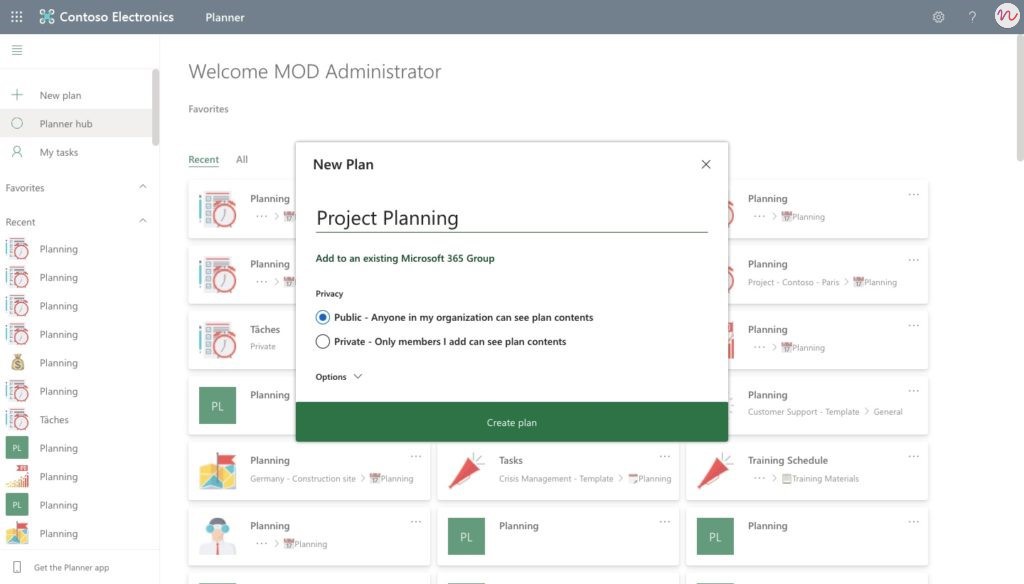
Okay, you’ve created a new plan, what’s next? Then you start adding cards with tasks, structuring them, and quickly transferring them from one board to another.
Open any card and you will see many additional functions. Here you can set a deadline for the task.
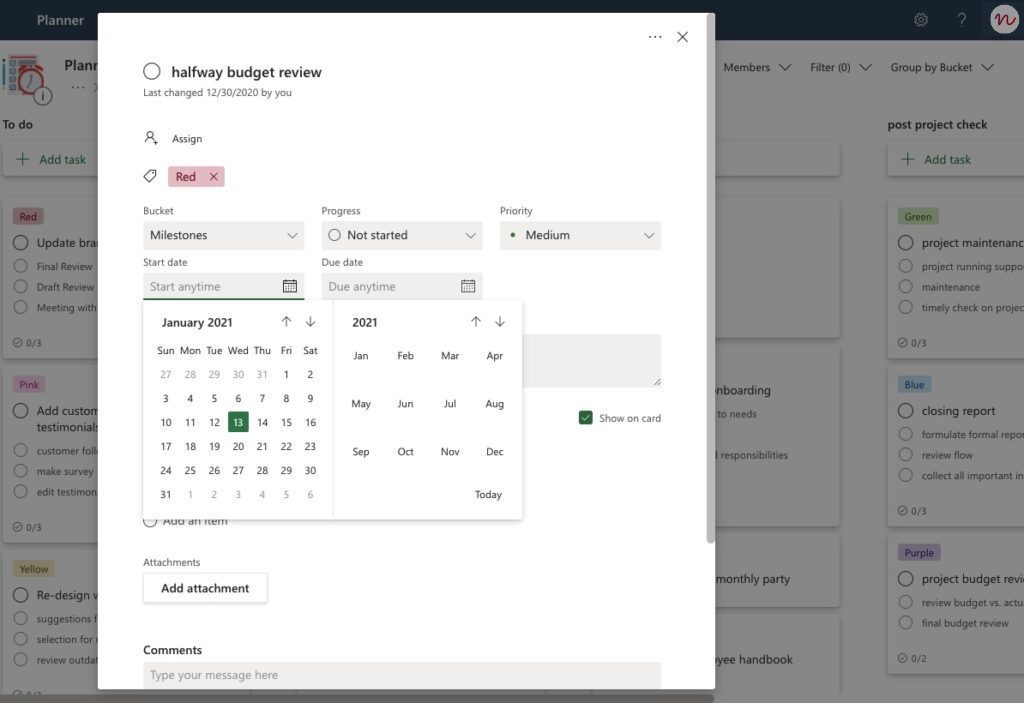
In addition, assign any person from your team for this task. Your team member (or members, if you choose several people) will receive a notification every time a new task is assigned.
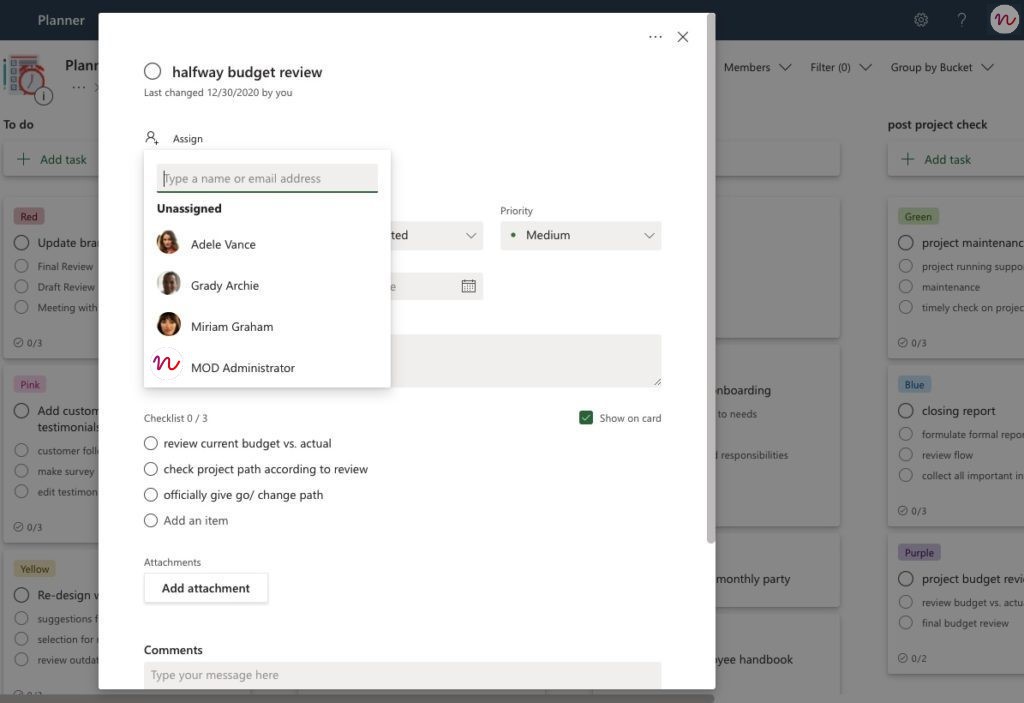
But how to make sure that the person understands exactly the essence of the task and will complete it correctly? To do this, you can easily add any content that will be displayed directly on the card.
Microsoft Teams & Planner: Best practices
Learn how to make the most of Teams <> Planner integration and build teams with pre-built Planner task boards
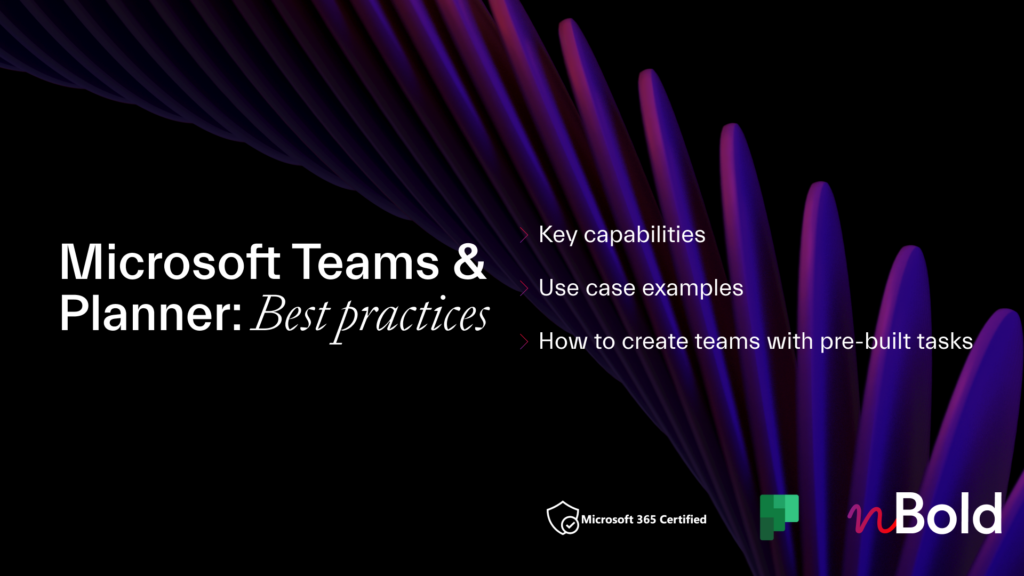
Label
What do the colored icons on the card mean? They help you categorize tasks and make them easier for your team members to find. For example, at nBold, our marketing team uses labels to represent a content type. For me personally, this is very convenient – I quickly understand what this is about: an article for our blog, a new video, or a social post.
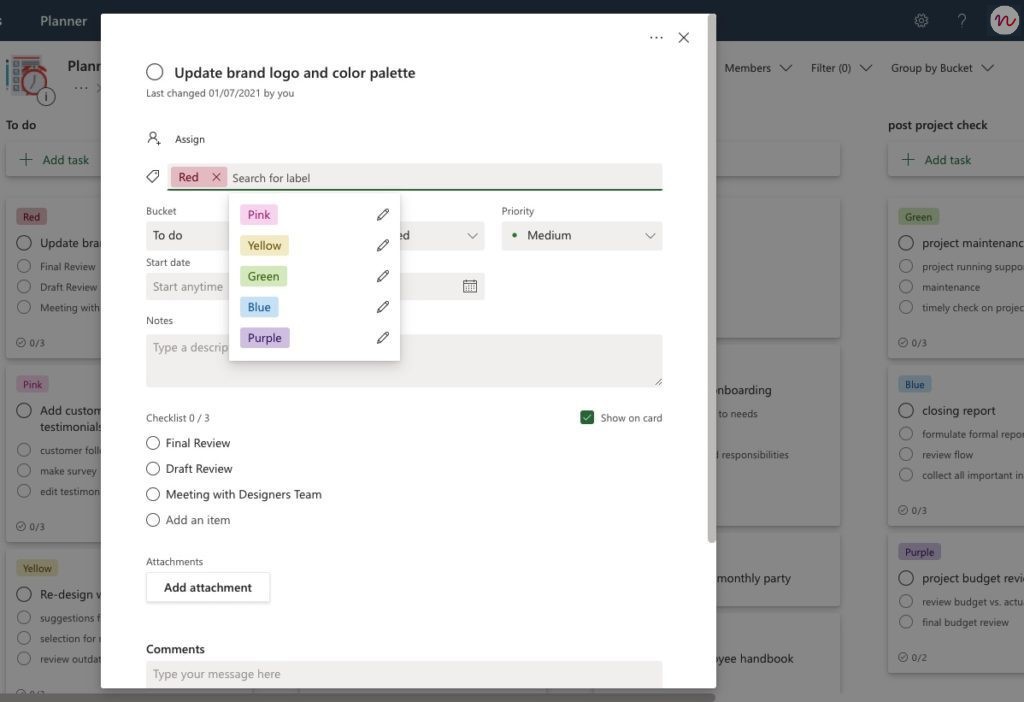
Checklists
Oftentimes, a single task involves several stages. To be sure that the project member doesn’t lose sight of anything, you can add a checklist with additional subtasks. Thus, you will improve the efficiency of execution
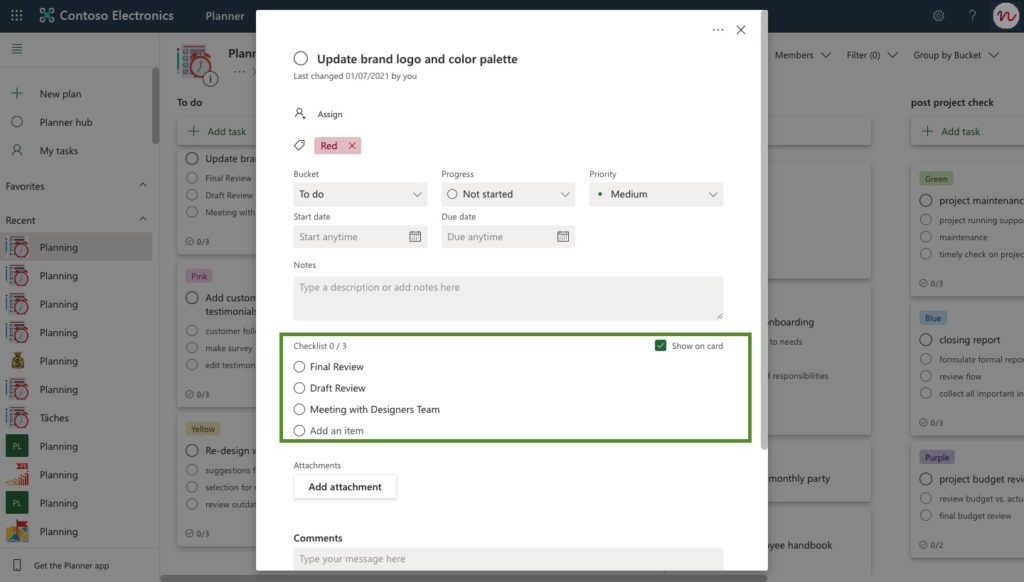
Attachments
Here, you can share content. You or another project participant can attach a document using SharePoint, upload a file from a device, or add a link. So, you can work together on documents and edit them online.
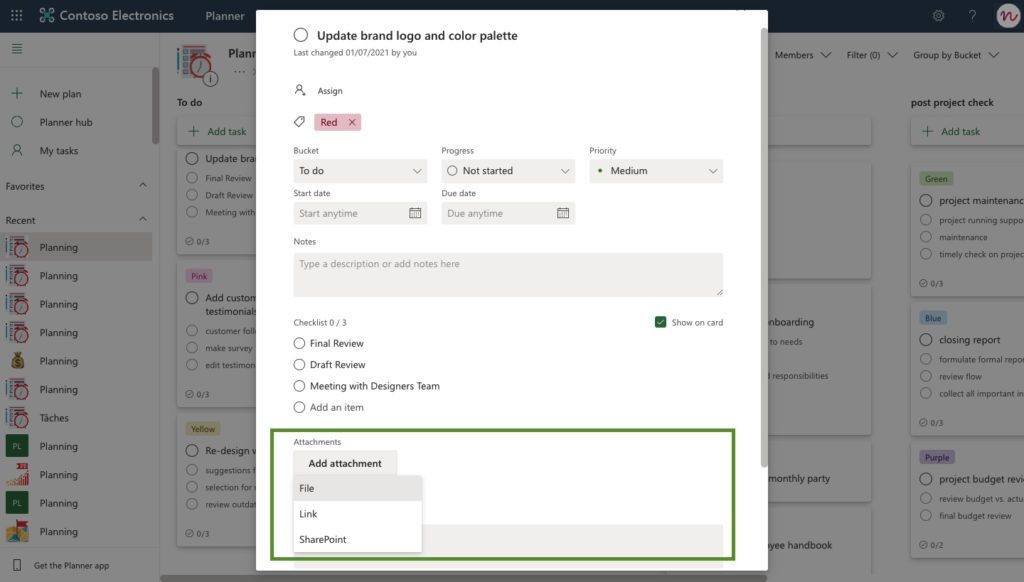
Notes and Comments
In the process of completing a task edits, comments, and discussions may occur. You can easily discuss the whole process with colleagues right on the task card.
→Download White Paper: Microsoft Teams & Planner Best Practices
Microsoft Teams with Planner
What’s great about Office 365 products is that they are all synced. You can read more about the Planner’s integration options with other Office 365 products here. Today we’ll talk about Planner with Microsoft Teams.
Let’s say you’ve created a team for a new project. You add several channels depending on your goals and the essence of the project. Next, you need to add Tabs with content to simplify and structure your work. As you may know, here you can add any application available in the Microsoft store as a tab, including Planner. Let’s look at what opportunities open when Microsoft Teams and Planner collaborate.
Planner features in Teams
After adding an existing plan or building a new one, you will have access to all Planner functionality right in Teams. You can manage Planner without losing functionality – manage boards, track deadlines, work on files without leaving Teams. You can even start a new conversation or a video meeting right from the Planner tab. This improves the work of the project team and the interaction of colleagues with each other.
Manage notifications
Each time, the employee will receive a notification directly in the Activity Feed if there have been changes in his tasks card. New tasks, attachments, new comments, etc. Easily stay informed and don’t miss out on project news.
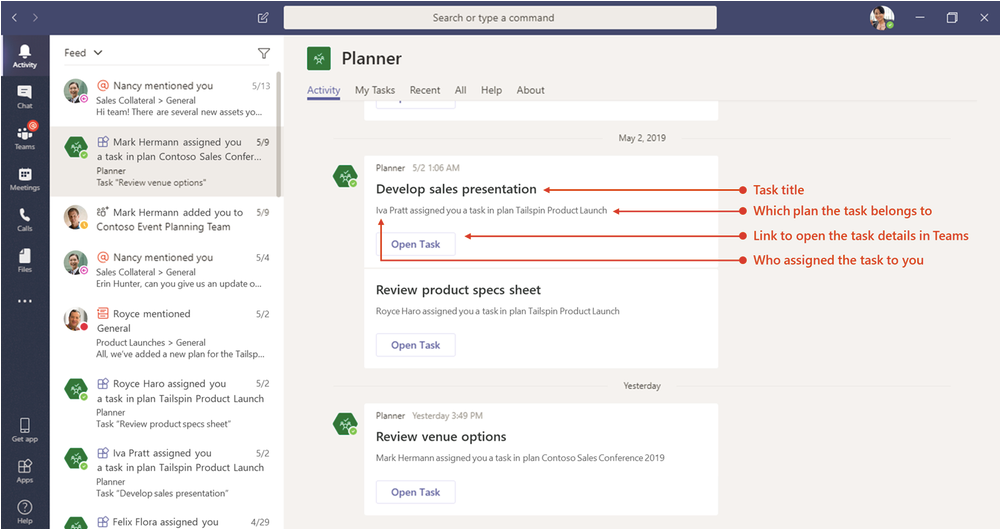
Microsoft Planner Templates in Teams
Alright, we figured out the functionality of Planner and how to connect it to the Microsoft Teams environment. But you still spend a lot of time creating a new Planner. You manually drive in each new task, re-attach files, and structure the process. In large organizations, doing many projects at the same time can be maddening. And instead of increasing your productivity, you waste time on repetitive work. Is there a way out? Of course, for this, we suggest using the Microsoft Planner Templates.
Save Time
Execution time is a key indicator of project success. This is especially important when you need to quickly launch a new project. With the Planner Template, you can easily reduce the time spent creating a board for upcoming tasks. That way, you stay focused on the really important KPIs, and at the same time, you don’t lose the quality of work.
Improve Processes
Streamline your workflows quickly and efficiently. With the Planner Template, you can work more efficiently at the start of a new project. This is especially useful for processes of the same type with the same structure. In a few seconds, you will create a working environment for your team with ready-made boards and cards
Enhance End-User Experience
Oftentimes, in multitasking mode, unstructured boards with tasks can wreak havoc. Your colleagues create tasks without special rules or guidelines, and instead of improving productivity, you end up with clutter and missing out on important steps. With Planner Templates, your project team will receive the pre-built workspace, where everything is clear and standard.
How to build Microsoft Planner templates in Teams?
Copy the existing Planner
One way to do so is simply copy an existing plan. How does it work?
For example, you create your Planner for a new project once. The next time a new project comes up, you need to re-create the team. And instead of manually building all the tasks, you can choose the “add an existing Plan” function. Just select the required Planner Template from the list and add it to the new command in one click.
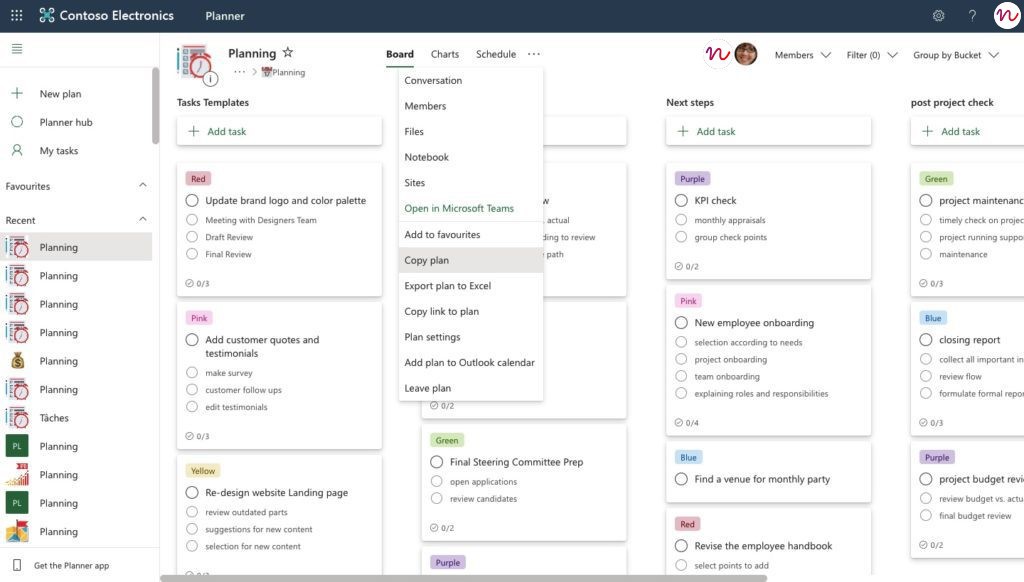
Thus, you can create many Planner Templates for different purposes, copy them into new commands, and optimize your work very easily.
Collaboration Templates with Planner by nBold
We suggest another more efficient option – copying Planner with Collaboration Templates by nBold.
With nBold, you can easily create dozens of Microsoft Teams templates for your organization. Thus, without losing end-user experience, you can structure your workspace in Teams, save time, avoid duplication, and mess of teams. And what about Planner templates? Let’s see how this works.
Create the Original Team
First, you create an Original Team for project management. You already know the structure of working with projects in your organization, so you can easily create the channels that will be required in the work on the project.
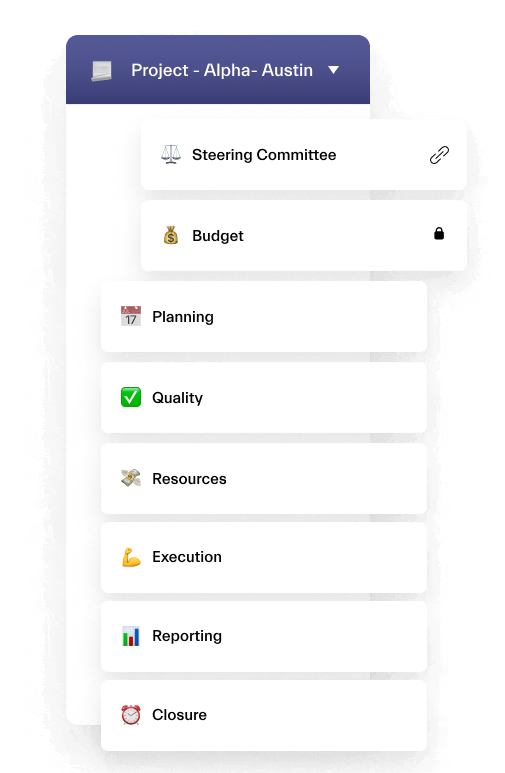
Here’s an example of a project management teams with different channels:
- Steering Committee
- Budget
- Planning
- Quality
- Resources
- Execution,
- Etc.
You can create not only standard but also private channels for collaboration on important and high-secured files.
Next, you need to add content. Here, you add Planner as a new tab as usual. Using all its features listed above, you can create a clear structure with to-do tasks and boards.
This Planner will be added to the template, which means that whenever you create a new team from it, it will include your pre-built Planner.
What else? You can also add any other app. For example, SharePoint, Yammer, Power BI, Forms, and more. Plus, you can integrate any 3rd party app like Salesforce.
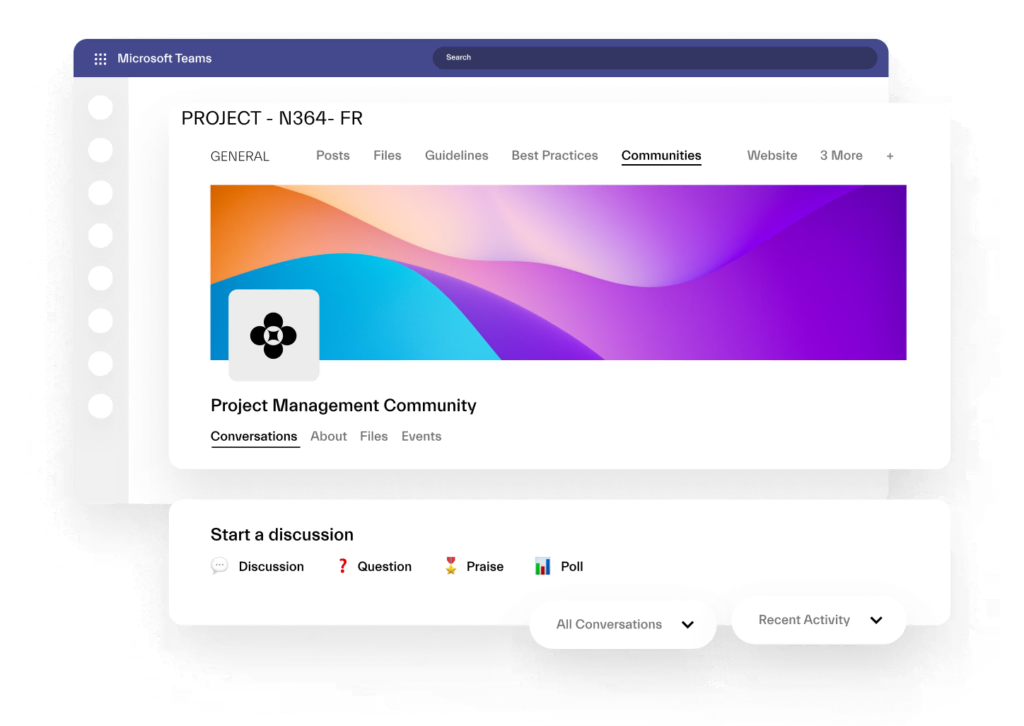
And that is not all! Your projects can have various documentation, guidelines, checklists, contract templates, and much more. These documents are used on any project in your organization! Upload them to your team and organize them into folders. Thus, the project team will have easy access to important files on any project.
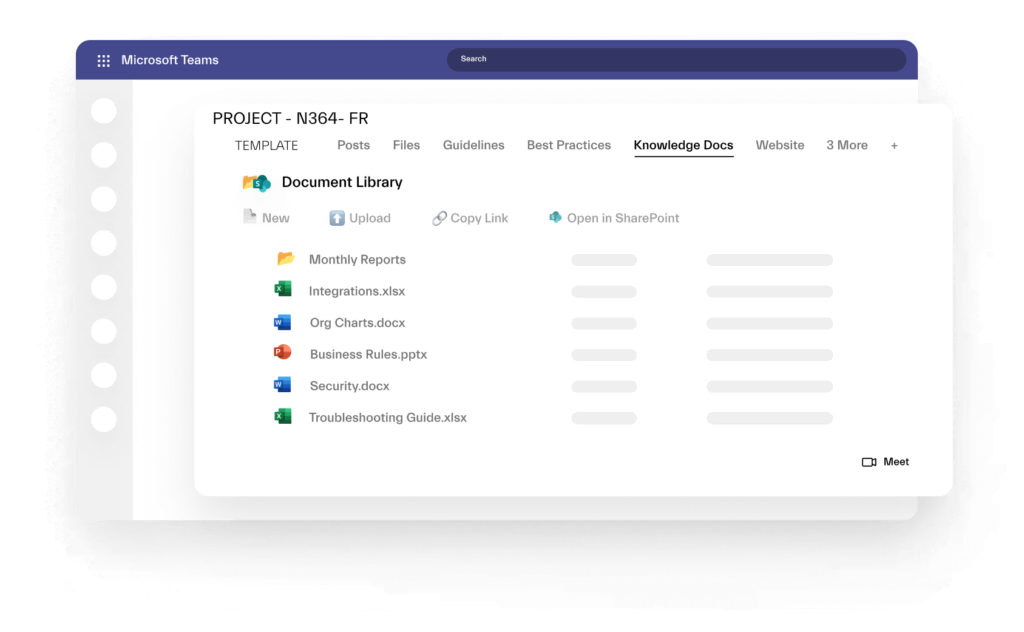
Add it as a template
Okay, the team is ready, what’s next? Next, add this Original Team as a template.

At this stage, you will be able to manage a lot of settings as well as Microsoft Governance:
Static or Dynamic Naming Convention with suffix and prefix. Based on Azure AD Data, this will help you to create the automated rules for your teams’ name, avoid duplication and mess
Approval Workflows allows you to define if a particular user can create the teams from your template or don’t
With Targeting Audience, you can define who can see your templates in the template catalog. Based on Azure AD Data, users can see different Templates depending on their level of access.
Using Permanent Membership when a new team is created from your template, someone in your organization will be added automatically as an owner or member
Enforce Security Setup to manage team privacy and membership policies
Get your own Template Catalog
After saving, the Project Management Template will be added to your own Template Catalog. There are dozens of Teams templates stored here to help your organization according to your needs. Project Management, Sales Deal Room, Crisis Management, Departments Collaboration, and much more.
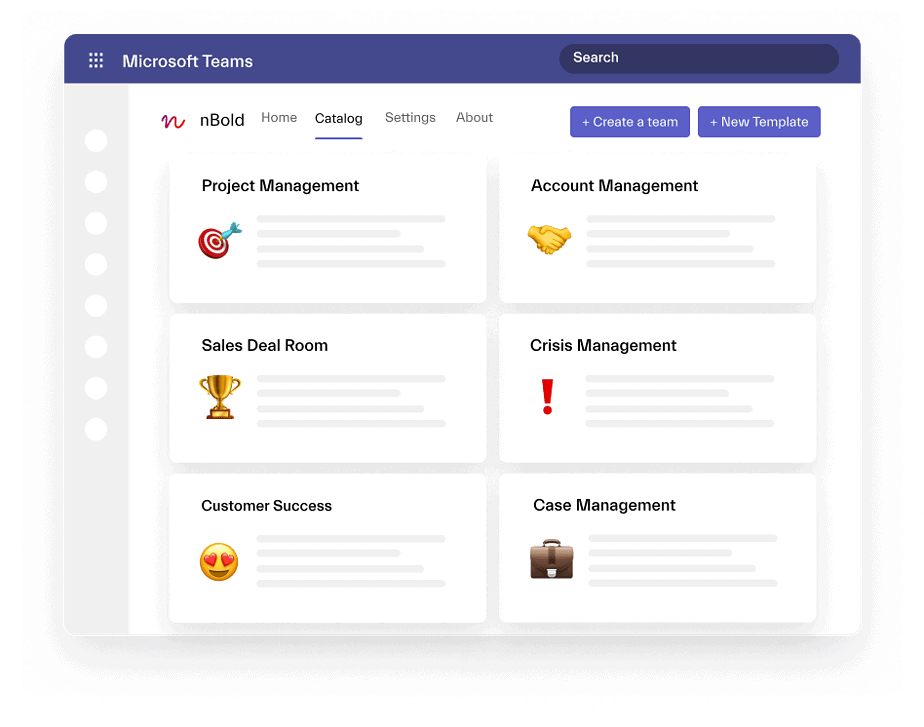
Use it!
Alright, everything is ready to use! Next time a new project comes up, you, as a manager, will not need to create teams from scratch. You just select the required template, and the fully provisioned team will appear in a matter of seconds.
So, in just a few steps, you can scale it across your entire organization. A clear and structured workspace, strong governance rules without burdening the IT Department, saving time and improving the productivity of your colleagues.
Sounds interesting? Talk to our team to learn how you can use Collaboration Templates for your specific scenario.
Microsoft Planner Template examples
Now that we know how to create Planner templates, let’s walk through some of the common examples.
1. Microsoft Planner Template for Account Management
The account management process is all about multitasking. You need to communicate with customers and prospects, your internal team, and management. Microsoft Planner can help you organize yourself and your team to stay informed about product updates or any changes.
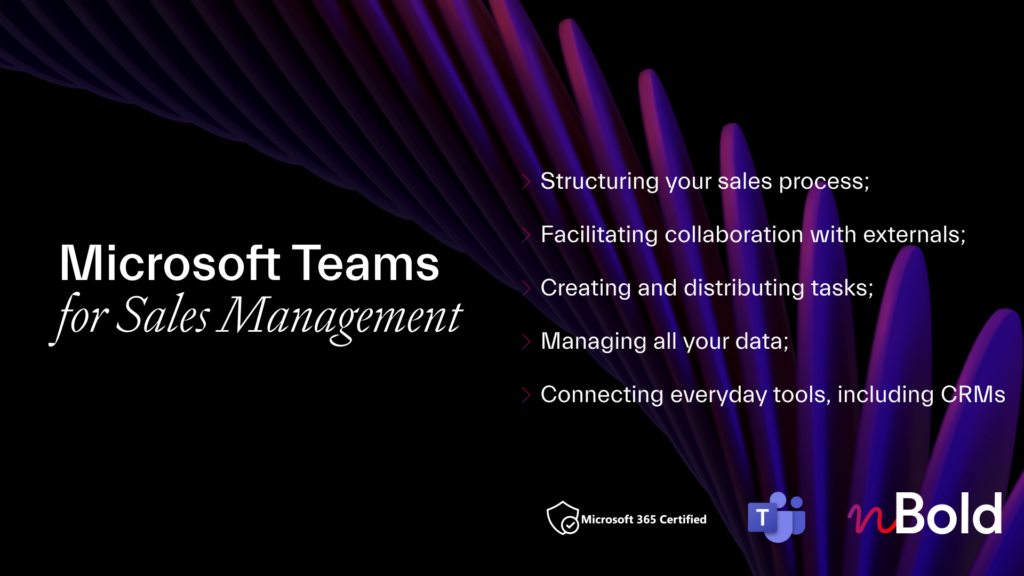
White Paper: Microsoft Teams for Sales Management
- How to use Microsoft Teams for Sales Management
- Create Teams templates for your sales processes
- How to connect Salesforce with Microsoft Teams
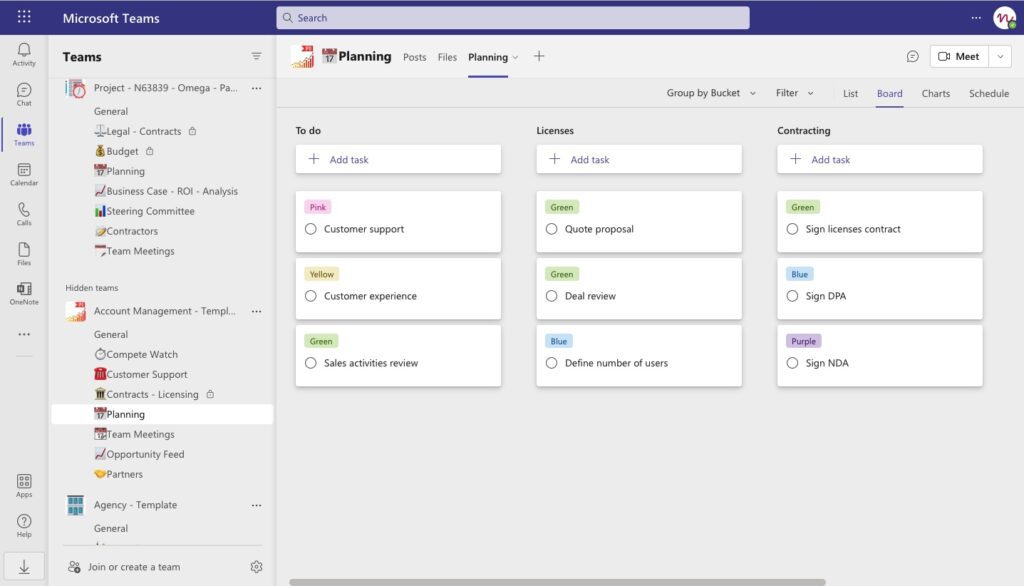
Create different boards and manage supporting documentation with tasks:
- Maintaining the key account database
- Weekly account plan
- Strategy formulation process
It’s very useful to attach the needed files right to your tasks. You can upload them from your device or search through Teams channels. In addition, you can label your tasks and quickly prioritize them. As a result, your tasks and supporting documents are structured and well-organized.
2. Microsoft Planner Template for Project Management
As a project manager, you may face missing deadlines, miscommunication between team members, and ineffective project execution. You should track the daily activities of your project team, set up deadlines, and quickly react to any changes.
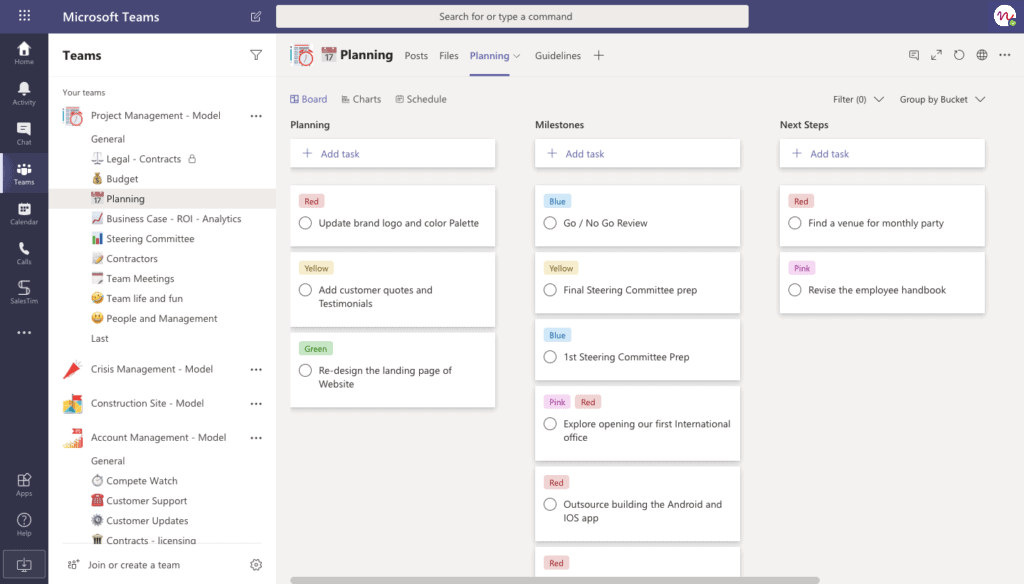
Build Microsoft Planner right in your Planning Channel with the following boards:
- Planning
- Milestones
- Next Steps
Thus, you can stay focused on project steps and your team won’t miss KPIs and deadlines.
Include different tasks according to your needs, for example,
- Update brand logo and color palette
- Add customer quotes and testimonials
- Re-design the landing page of the website, and more
Next, attach the guidelines and useful links to your tasks, and set up the project management agenda. This way, your project members will see their tasks deadlines, and all the information they need to complete them.
3. Microsoft Planner Template for Crisis Management
Crisis management is a process of preparing and dealing with any abrupt and unexpected situations affecting the organization. In order to resolve a crisis, you need to have a well-thought crisis management plan.
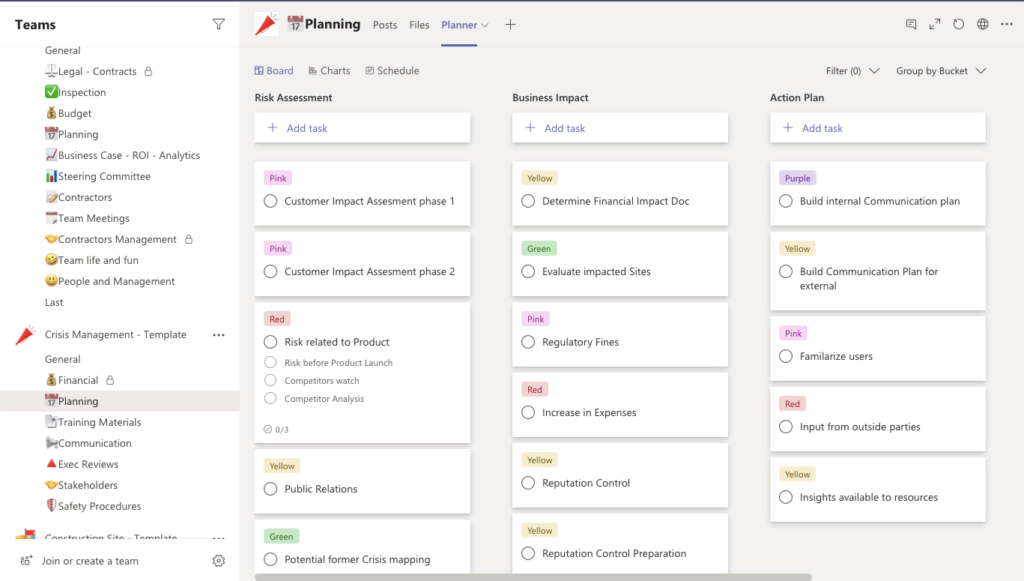
Define risk assessment, for example:
- Risks related to the product
- Public Relations
- Potential Crises, and more
Next, you can add a checklist to specify the task and not miss any step:
- Risks before the product launch
- Competitor watch
- Competitor analysis
Don’t forget to assign tasks to people in your team. When your Planner Tab is built, everyone in your Crisis Management team will see this. They can filter the Tasks Boards according to Date, Board, Assignment, Deadline, and more. In addition, they can easily start a conversation to quickly react to any risks.
4. Microsoft Planner Template for Construction Site
Meeting deadlines and commissioning in time is your crucial goal. To do so you need well-thought-out planning. You should manage all processes step-by-step and not miss any information from partners, and customers, and other stakeholders.
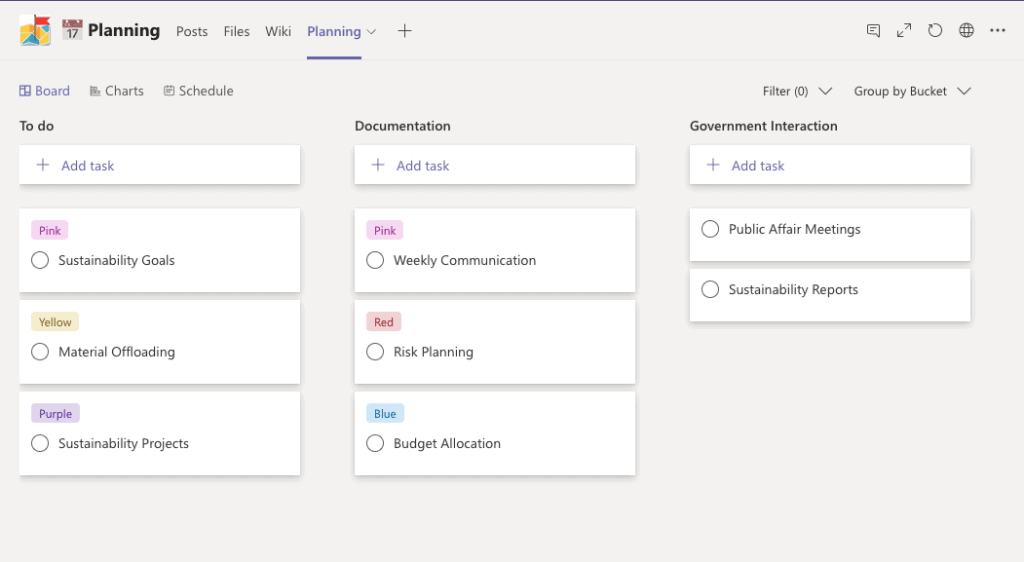
In this case, you can build Planner with Following Boards:
- To Do
- Documentation
- Government Interaction
Add different daily tasks, for example:
- Sustainability Goals
- Material Offloading
- Sustainability Projects, etc.
You can easily change the Planner view in Schedule. There you will see the calendar with all the tasks that you should perform in the upcoming week, month, etc. It’s very convenient to see your plans in one place for the next few days and choose any task according to your daily activities to finish the project on time.
5. Microsoft Planner Template for Sales Deal Room
In today’s collaborative way of working, many players from different departments could be included in the sales process. And It’s extremely important to build a planner with assigned tasks and deadlines. Otherwise, you may experience fewer closed deals, late deadlines, and low employee engagement within your sales team. Let’s look at the Planner example for the sales deal room.
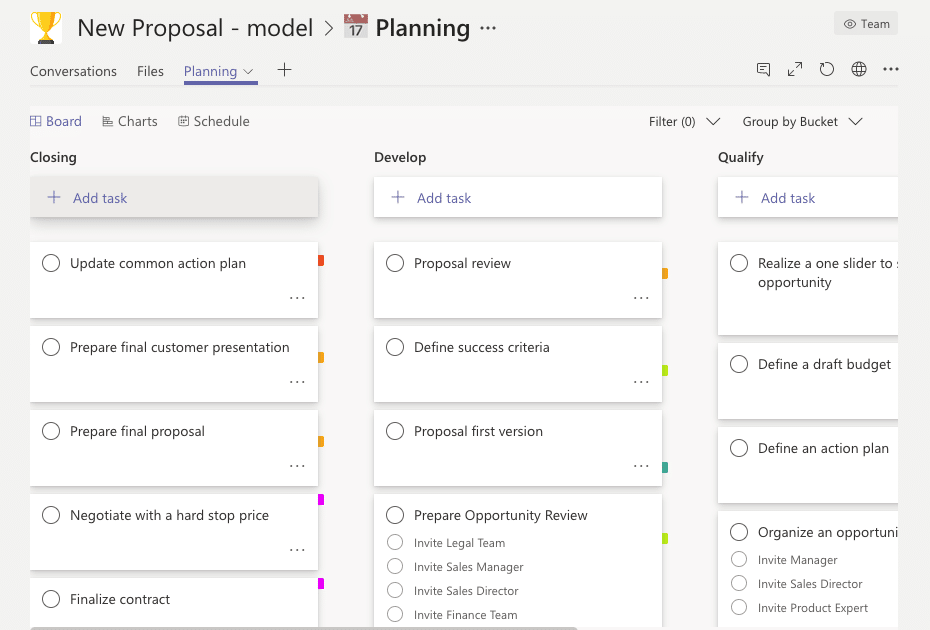
During the Develop Step you can add such tasks as:
- Proposal Review
- Define Success Criteria
- Proposal first version
- Prepare Opportunity Review
You can also assign tasks to a group of people. For example, to prepare Opportunity Review, you can add the checkbox with all required participants such as Sales Director, Legal Team, Finance Team, and Sales Manager.
Another great feature is the possibility of your sales team to track not only their tasks and assignments but also the planning dashboard for the full team. This way, they can stay focused on the common vision and progress of the sales process.
Learn more about Sales Deal Rooms in Microsoft Teams.
6. Microsoft Planner Template for Customer Support
Even after a deal is closed, companies need to keep in touch with their customers in order to receive feedback. In customer support, it is necessary to respond quickly to feedback and resolve any issues by interacting with the product management team.
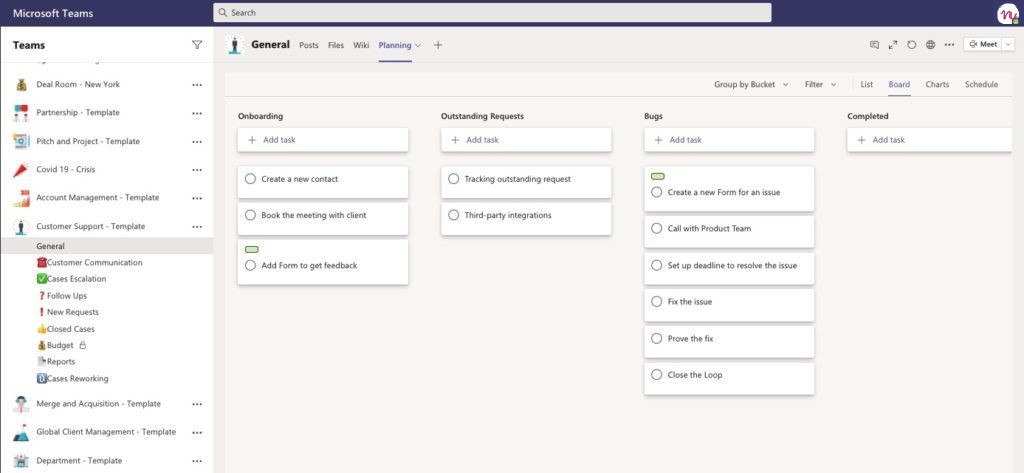
Here are the Buckets examples:
- Useful Information with Document Templates and Guidelines
- Onboarding
- Outstanding requests
- Bugs
- Completed
- Lost
Your team members can easily use your board as a template. Just create the “New Request Template” with all needed content, documents, and checkboxes. As a result, in a few second, they will be able to create a new Request and move it to needed board.
7. Planner Template for Content Marketing Management
Today every company needs to successfully manage marketing campaigns. Your marketing department should publish blog articles, produce video content, develop website pages, maintain social media, and more. This process requires an effective review system, adherence deadlines, and constant internal collaboration. Let give us some insights. We offer you a Planner Template that we use at nBold in our Marketing Department.
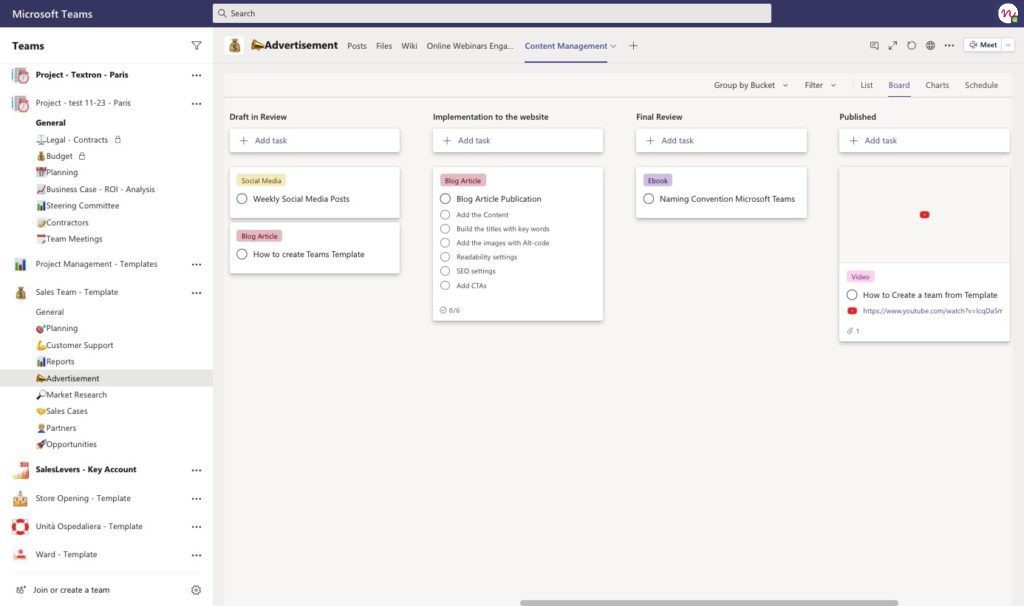
Create the Buckets according to the different steps:
- Content Ideas
- Outline in Review
- Draft Content
- Draft in Review
- Implementation to the website
- Final Review
- Published
You can create a new board for each piece of content. For use, it’s very useful to add the labels according to the type of content: Article, Video, Gated Content, Web Page, Email.
In addition, you can add a checklist at the implementation step. Follow these steps to publish your article to the website:
- Add Text
- Build the Titles with key words
- Add the images with Alt-code
- Readability Settings
- SEO Settings
- Add CTAs
It’s so easy to attach drafts and links and collaborate on content across the company! Verified by nBold 😊
8. Microsoft Planner Template for Event Management
Event management is a multi-stage process that involves overseeing all organization leading up to the event. During the event management, you should execute the events plans by managing staff, finances, vendor relationships, and more. No matter, you should organize an internal conference, or external event, you should always follow standard steps, such as coordinating outside vendors, engaging speakers or entertainment, crisis or situation management at the event, monitoring, etc. Let’s create a Planner Template for Event Management.
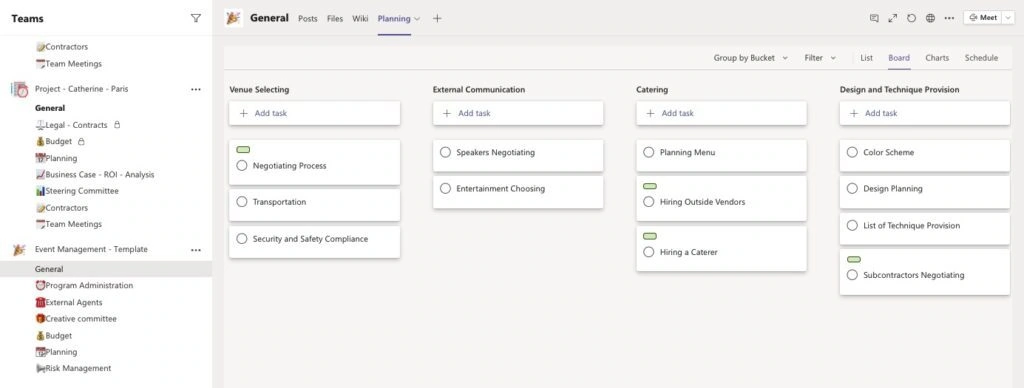
Add the different Buckets:
- Upcoming Events
- Finance Planning
- Venue Selecting
- External Communication
- Catering
- Design and Technique Provision
- Risk Management
It’s very important to get ready in advance for the event and not miss a single detail. You can choose the Calendar view. Thus, your event management team will know exactly when the tasks must be completed.
9. Microsoft Planner Template for Product Launch
Developing new products is a critical process for many brands to maintain growth and enter a new market. However, companies face many challenges during this process, for example skipping vital development phases in order to save time. During the new product launch you should not only develop your product and prove its viability, but also establish an initial price, lead customers; and implement actionable post-launch refinement. In order to successfully execute a new product launch, you should create an effective plan to allow your team to collaborate on this process.
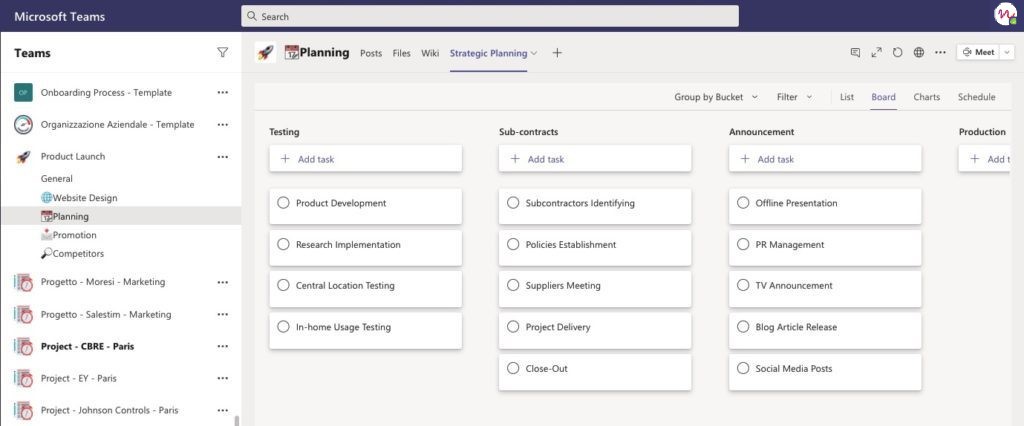
- Testing
- Sub-contracts
- Announcement
- Production
Add the different tasks to your Announcement buckets to use all communication channels such as:
- Offline Presentation
- PR Management
- TV Announcement
- Blog Article Release
- Social Media Posts
This Planner board will help you to collaborate on the product launch process and share documents without jumping from one application to another.
10. Microsoft Planner Template for Website Design Management
Web design is not only about focusing on technical matters, such as codes and wireframes. An effective design is about having a website creation process that aligns with the overarching strategy. And of course, it’s not easy to achieve a harmonious synthesis of elements without planning and collaboration across the team. You can get inspiration for your planning process using this Planner Template.
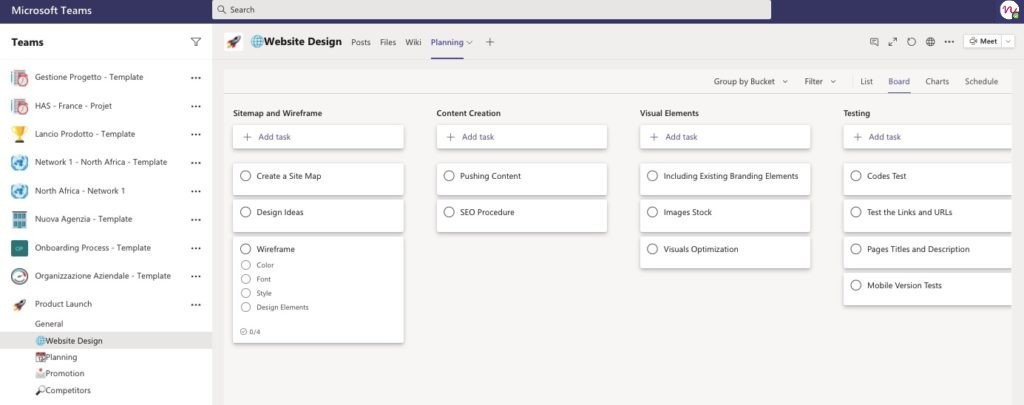
- Scope Definition
- Sitemap and Wireframe
- Content Creation
- Visual Elements
- Testing
- Launch
Don’t forget that you can easily attach the links right to your boards in Microsoft Planner. In addition, you can prioritize your tasks and stay focused on urgent issues. One more feature is to change your View on the Chart tab. It will give you a high-level overview of the tasks. You can see the visual graphics with the status of tasks (not started, late or in-progress) and see where the tasks are assigned.
11. Microsoft Planner Template for Onboarding
When you hire a new employee, it’s important that we can be quickly integrated into your organization’s processes. However, when a person doesn’t know anything about your product, the tools you use, and organizational policies, he can get lost in the norms, not knowing where to start. So as not to delay this process in time, you can help them with a built plan, where he will gradually get acquainted with the important elements.
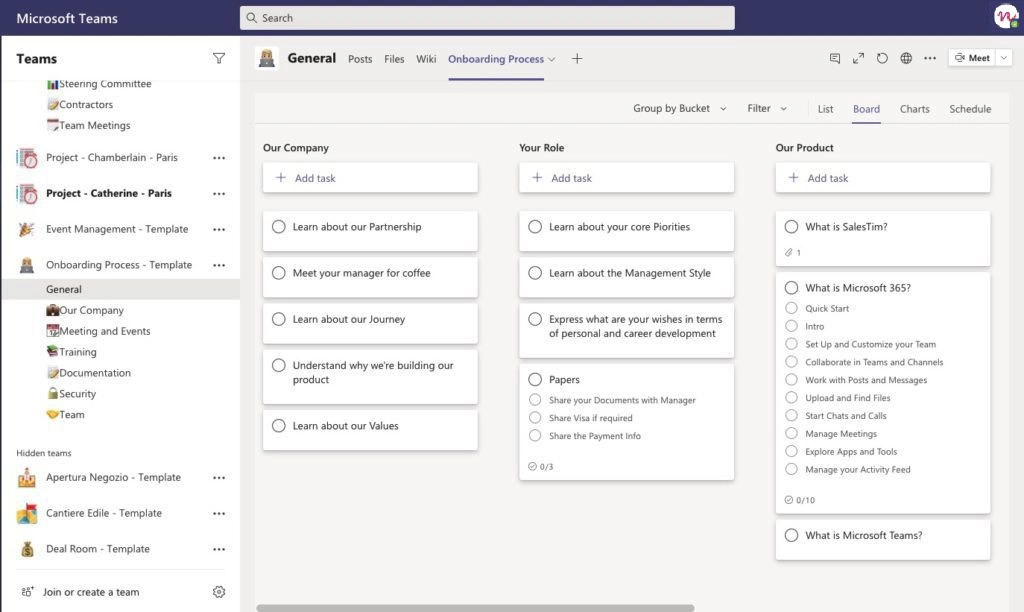
You can create the following buckets for your new employee:
- Our Company
- Your Role
- Our Product
- Tools and Integration
Add the tasks, for example:
- Learn About our Values
- Understand why we’re building our product
- Learn about our journey
- Meet with your manager for coffee
- Learn about our partnership
Thus, your employee can learn about the company, tools, and his role step by step. Don’t forget about the possibility of Planner integration with other apps. For example, when you assign the Planner task right in your Teams environment, the worker will be notified in Teams in the Activity tab. In addition, you can build a workflow, where they will receive the notification into Outlook. This way, they are notified about the task and won’t miss anything.
Learn more about how to onboard new employees with Microsoft Teams.
12. Microsoft Planner Template for Recruitment
Let’s imagine, you have an HR team for each of your departments. Recruitment involves many steps: finding, selecting, negotiating, and hiring itself. You should manage properly this process to attract the right job candidate and quickly close free positions. In addition, you should collect a lot of data from potential candidates, set up interview meetings with them and give feedback. Planner can help you run the hiring process and maintain the constant development of the company.
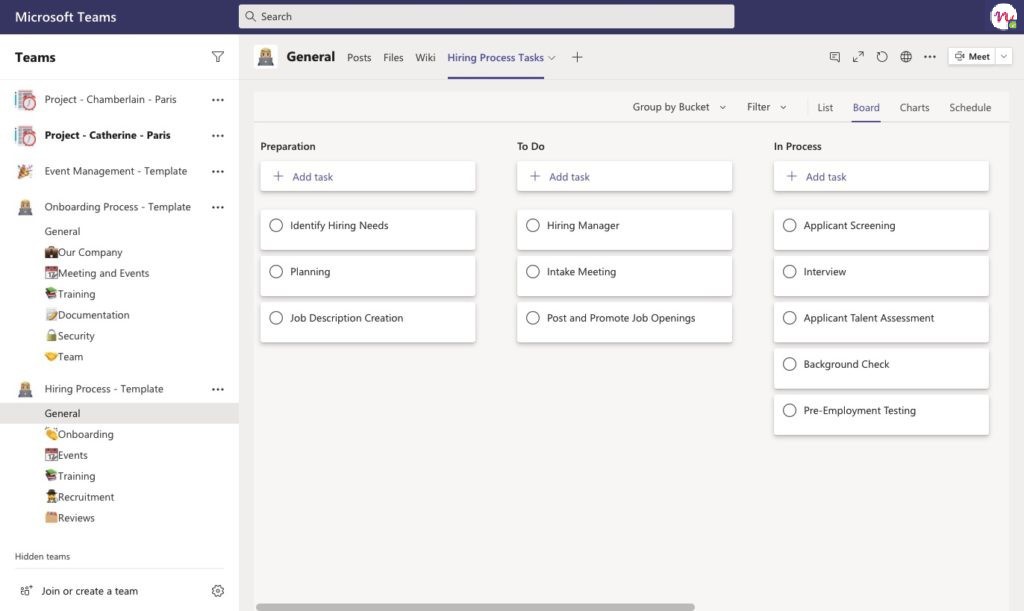
- Preparation
- To do
- In process
- Hiring Process
Add the following tasks to the Hiring Process Bucket:
- Final Interview
- Security Procedure
- Documents Signing
- Create a team dedicated to the Onboarding Process
As a result, you can manage planning for your hiring process with Microsoft Planner and Teams integration. In addition, Planner can help you to manage all CVs, recommendations, contracts, and other documentation. Remember that you can upload files directly to the task in the Planner? This is how the integration with SharePoint works. When you click on the Files tab, you get to SharePoint – the space where your entire organization stores and exchanges files.
13. Microsoft Planner Template for Procurement
No matter if your business is purchasing new computers or looking for an external agent to train employees, it’s helpful to follow a step-by-step process. This will ensure you get what you need according to your budget and expectations for the product or service. By following a business purchasing process, you won’t only complete your purchase but also examine the results, thus you know what may work better for future purchases. Try to build your own Planner dashboard based on the following example.
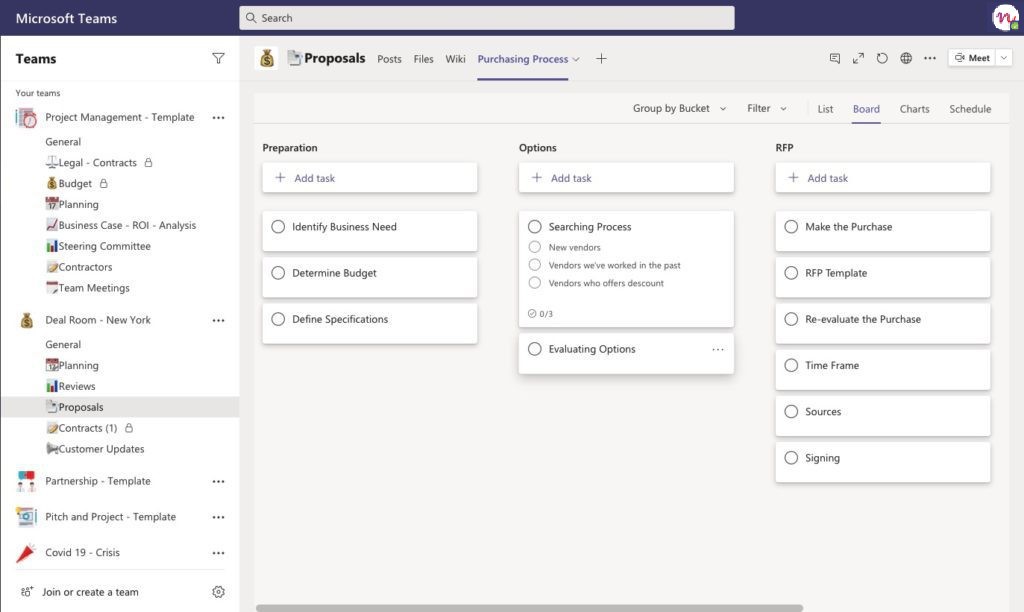
Add the Buckets according to the purchasing steps:
- Preparation
- Options
- RFP
You can add a checklist with Vendors during the Searching Process:
- New Vendors
- Vendors we’ve worked in the past
- Vendors who offer discount
Thus, with Microsoft Planner you easily run any purchasing process without missing deadlines and miscommunication between involved agents. Let’s keep talking about Planner integration with other apps. Let us give you an idea of how you can quickly track new RFPs. Create the Microsoft Form where your team can submit all needed information for a new Purchase. With Microsoft Flow, you can connect your Planner with Forms. Thus, a new task will be automatically created when Microsoft Forms is submitted.
Learn more about how to manage procurement in Microsoft Teams templates.
14. Microsoft Planner Template for Audit Management
Audit management is the process of verification that all company processes are aligned with strategic goals. Thus, you should track many collaboration silos one by one. To get the right information and stay focused on each process, you can build Planner with tasks, deadlines, and prioritization.
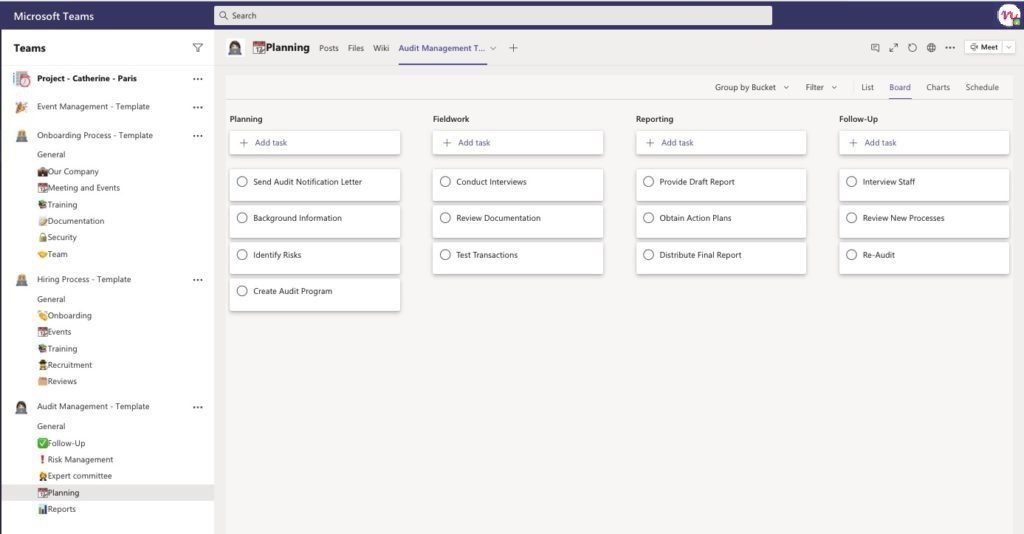
- Planning
- Fieldwork
- Reporting
- Follow-up
You can easily start new conversations with your colleagues right into the Planner tab to quickly react to any changes and risks. One more option is to leave comments and notes right into the task board.
15. Microsoft Planner Template for Partnership Process
During the Partnering Process you should carefully plan all activities with potential partners. During negotiations, you may face a long coordination of various elements and organizational resistance. At the same time, you need to meet deadlines and follow the process step by step. Without planning you can face a lack of pre-established goals. Explore our Planner example that you can build when a new team with a potential customer was created.
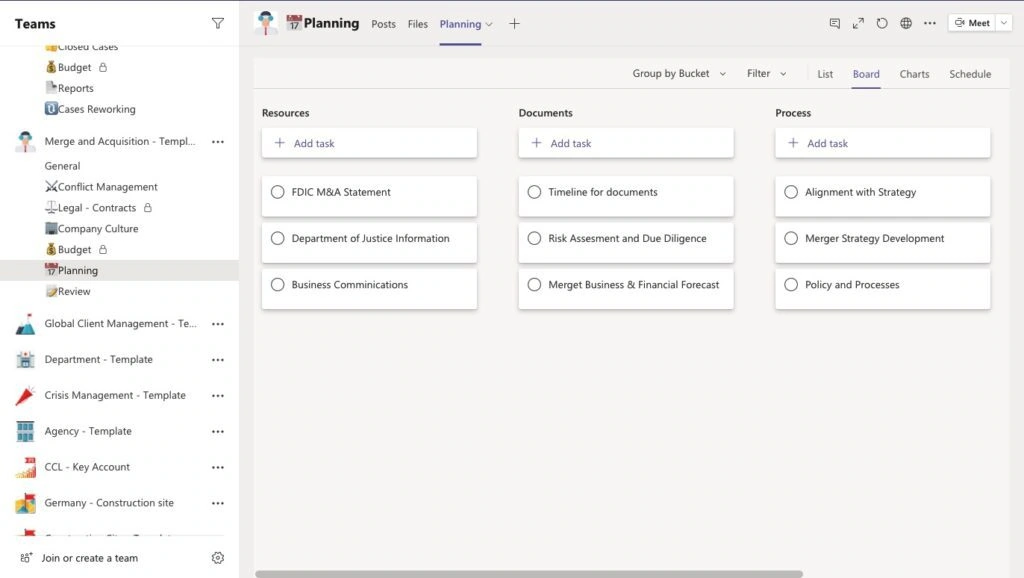
Add the different buckets:
- Resources
- Documents
- Process
And don’t forget to add the different tasks, such as:
- Alignment with Strategy
- Merger Strategy Development
- Policy and Processes
Schedule tasks, assign any person in your team, and track the progress easily with Microsoft Planner. Develop your partnerships and follow the steps in collaboration with your colleagues and external agents.
There you have it! Planner is an easy-to-use task management tool. If your projects are not too complex it can be an ideal solution for your team. And with the right approach and by using Planner templates you can save yourself quite a bit of time and drive better results in no time! You got it 😉
